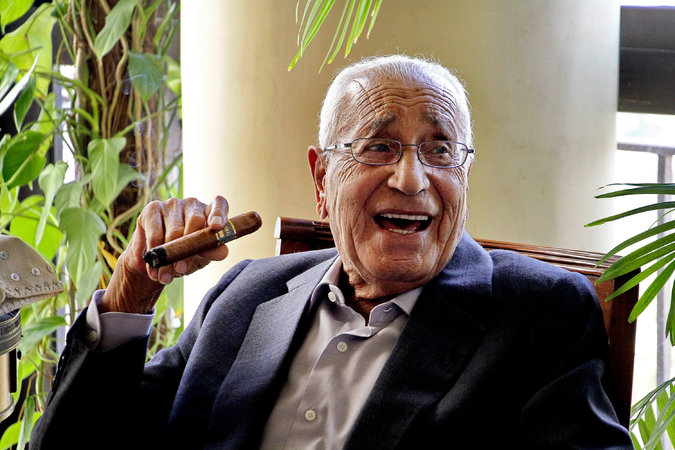
Mohamed Hassanein Heikal joking with friends in 2015 at his home in Cairo, days before his 92nd birthday. Credit Ahmed Abd El-Latif/Associated Press
The brilliant late journalist Mohamed Hassanein Heikal is considered a great chapter in the history of the media and political conflict in Egypt and the region. Heikal was both a witness and a partaker during the reigns of King Farouk of Egypt, President Gamal Abdel Nasser, President Anwar Sadat, President Hosni Mubarak and finally the Egyptian Revolution of 2011.
Heikal, a few days ago, retired from life itself, may Allah rest his soul in peace, ending a life-long career he spent in journalism. He was a journalist reporting on frontiers, palaces, and streets until his heart gave in during his 90’s. Heikal was exceptionally creative in his domain, a permanent media and political valuable asset, regardless of what others, me being one of them, thought of what he had to say, write and produce.
My explanation for the controversy surrounding Heikal, among those who glorify him and those who hate him, is that it stems from a division flanked by the journalists themselves and their political orientation.
Those pro-Heikal’s political camp applaud him with no question, while others on the other side come down on him without the benefit of doubt either. The position Heikal occupied was to control media publicity during Gamal Abdel Nasser’s time in power. When we take this position in specific to scale on most of his statements, writings and lectures we obtain a better understanding of Heikal and come to appreciate his work. For example, Joseph Goebbels, Reich Minister of Propaganda in Nazi Germany, was a distinguished master in managing the mechanisms behind Nazi publicity. His theories are still taught at mass media institutes.
Heikal himself was also a distinctive teacher and an accomplished journalist when it came to propaganda. He had built-up his name and success during Abed Al Nasser’s rule because media propaganda was one of his three great defenses, along with politics and military. Heikal’s media excellence was one of the reasons behind Abdel Nasser’s popularity, who was a media-dependent president. Abdel Nasser used media to endorse his legitimacy and manage large-scale battles. He used it for the nationalization of the Suez Canal, the shift to a socialist camp, and getting involved in Soviet media campaigns against the U.S., Israel and the Muslim Brotherhood. Not only that, but media propaganda also helped Abdel Nasser justify the war in Yemen and the grave losses it entailed, in addition to his dispute with Riyadh, Baghdad and Damascus later on.
One of the greatest challenges that ever faced Heikal and brought about his first media whitewash, was having to overcome the aftermath of the 1967 defeat. Heikal’s attempts at patching up what had happened, rephrasing facts, such as calling the defeat against Israel a “relapse”, and the withdrawal from Yemen a “reconciliation” rendered futile. It only took students a year before they started protesting against Abdel Nasser in Cairo University, given that it was previously an arena for demonstrations supporting him.
Heikal publicity attempts were unsuccessful in convincing many people, or explaining Abdel Nasser’s inconsistency when he had taken in U.S. Secretary(at the time)Roger’s initiative on negotiating with Israel. When Abdel Nasser took that step Palestinian camps fired up with protests and denouncement.
In my opinion, it was not Heikal who had failed in managing Abdel Nasser’s mass media publicity after the July defeat, it was rather Abdel Nasser failing in understanding the nature of Heikal’s propagandist post. The late President Abdel Nasser wanted to validate flagrant contradictions post his defeat. He wanted to preserve the image Heikal had established for him, the Arab nationalist leader confronting imperialism and Zionism, and at the same time deal with imperialist Washington, negotiate indirectly with Israel, reconcile with Saudi Arabia after having promoted it to be a fanatic-based camp, and cut down his dependence on the Soviets after discovering their letdown on supporting him when he needed it the most.
In my personal view, Heikal had it in him to repaint Abdel Nasser’s image from the Che Guevara- inspired hero to the forgiving nation-anchored Ghandi, however, Abdel Nasser did not wish to let go of his glorious image.
It was already late when Heikal himself realized the huge gap between what he was administering to the public and what was really happening. During the war he promoted military data he received, publishing it on the headlines of the Cairo newspaper “Al-Ahram” front page: “Downing 130 Enemy Jets”, published on a Thursday morning attack, only for Heikal to later discover that the truth was quite the contrary. On that day, he discovered the horrid truth of not a single Israeli plane being downed. Alternatively, Israeli forces had successfully destroyed the Egyptian Air Force (EAF), its airports, and had managed to take over Sinai Peninsula, which is three times the size of Palestine. Israel had also dominated the Suez Canal, and no ship or carrier could sail without Tel Aviv granting its approval first.
To be continued…
